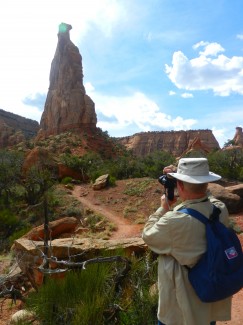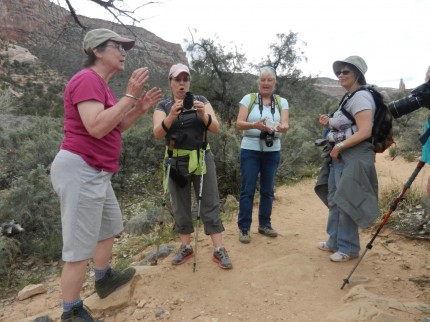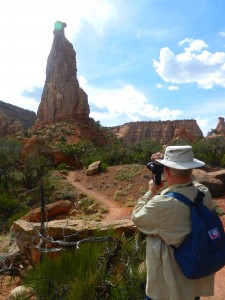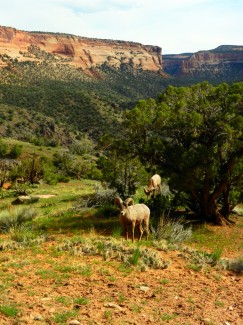Features Editor
Photos by Charlie Blackmer

(Wayne Hopper captures Independence Monument while on a hike with professional photographer Donna Fullerton as part of the CNMA's Spring Walks & Talks series.)
The landscapes found in the Colorado National Monument are majestic. Wait, stunning. No, resplendent.
It can be a challenge to capture natural beauty in words. So what about in photographs?
On Saturday, as part of the Colorado National Monument Association’s Spring Walks & Talks series, professional photographer Donna Fullerton led eight participants on a hike to Independence Monument, offering photography tips and tricks along the way.
“I would generally never take pictures during this time of the day,” Fullerton said of the 1 p.m. hike. “The light right now is very harsh. When you’re able to get some shadows in your shots, it adds a little more depth to the photo.”

(Donna Fullerton, second from left, helps Rachel Richardson, far left, with her Minolta film camera.)
Fullerton worked as a photographer at Disney World in Orlando for many years before moving to Grand Junction nearly four years ago with her husband Steve. Before her Disney days, she practiced bronze and ceramic sculpture and painting as well as photography while enlisted in the U.S. Marine Corps.
“My dad bought me my first camera, an Olympus, when I went to Brazil as an exchange student [in high school],” she said. “I’ve always been pretty artistic, and I found I liked being behind the lens.”
While snapping landscape photos, Fullerton recommends keeping the shutter speed between 125 and 400, “because most of the time, nothing’s moving.” Additionally, keeping the F-stop between 16 and 25 will result in clear, crisp wide-angle photos.
As for ISO, “if you’re shooting at 800 or 1600 [outdoors], you’re going to get a lot of noise,” she said, referring to grainy pictures.
And wildflowers?
“It’s better to go earlier in the day, because by afternoon the wind starts blowing,” and the flowers’ petals will shift and fold.
As for those with little experience who wish to explore the art of digital photography, Fullerton says, “the most important thing is just to get out there and practice. Find out what your sweet spot is. If you take a great photo, use those same settings and try to re-create it.”
“You Tube has some amazing tutorials,” she recommends. “Even some of the point-and-shoot cameras can take great outdoor photos, but you have to get out there and try it.”
cblackme@mavs.coloradomesa.edu


Recent Comments